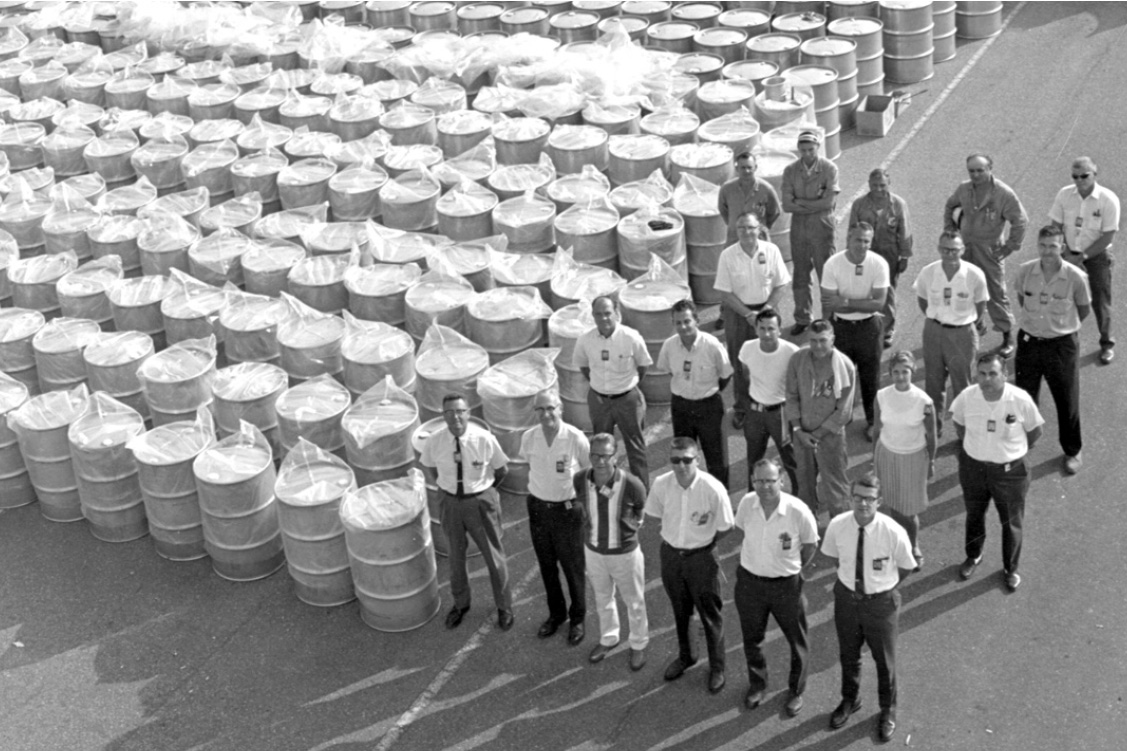SRNL Explores Treating and Re-purposing Heavy Water Stockpile
“There are more [uses for deuterium] coming for cancer-targeting drugs.” – Lucas Angelette

SRS personnel with a shipment of heavy water bound for Sweden in 1969 (SRS Archives).
Five nuclear reactors were constructed at Savannah River Site in the early 1950s to produce plutonium and tritium for nuclear weapons. However, none of the reactors could produce these materials, or even enter the initial start-up process, until the 400/D area at SRS came online. The massive 400/D area, one of the first production areas completed at SRS, was constructed for the sole purpose of supplying the reactors with heavy water.
Light water is the typical form of water, consisting of one oxygen atom and two hydrogen atoms known as protium, both containing one proton in their nucleus. In heavy water, the two protium atoms are replaced with deuterium, an isotope of hydrogen that also contains a neutron in its nucleus.
The reactors at SRS were unlike the reactors at the Hanford Site in Washington state that produced plutonium for the Trinity test and the atomic bomb dropped on Nagasaki. Those reactors were “moderated” with graphite, which meant they used that form of carbon to slow down to a controllable level the neutrons released from uranium atoms splitting apart.
SRS reactors were heavy water moderated. Heavy water is much better than graphite at moderating neutrons during the fission process, but it can also cool the reactors. Completion of the reactors at SRS was staggered so they could be brought online as 400/D produced the amount of heavy water they each required.
Heavy water operations at SRS were fully ceased by 1982, having produced what was needed plus a sizeable surplus. Most was used in SRS reactors or otherwise domestically, while much was sold to other countries. By 1989 all of the reactors were shut down, further adding to the heavy water stockpile. Thus, nearly 450,000 gallons of heavy water are sitting idle at SRS, awaiting some form of disposition. Much of it contains tritium, a radioactive isotope of hydrogen, along with other contaminants.

Cartoon from the SRL Promotional booklet, Nucleonics of Tomorrow in the Making Here Today (undated) representing the United States selling heavy water to the rest of the world.
The heavy water can be disposed of by immobilizing it in grout, but this is expensive and labor intensive. The Hydrogen Processing Group at Savannah River National Laboratory was approached by the Department of Energy Office of Science to explore ways of removing the tritium from the heavy water so it can gain new life.
SRNL’s Dave Babineau is the project lead, and Lucas Angelette is the technical lead. Angelette says that the demand for heavy water and deuterium is gaining steam, with new uses emerging each year. Other countries use heavy water moderated reactors for power generation, including Canada, but that country does not currently produce heavy water.
Deuterium is used in semiconductor production and in the medical industry. “There are more [uses for deuterium] coming for cancer-targeting drugs,” said Angelette. Literature has shown that the deuterium concentration can actually accelerate or inhibit cancer growth. The cancer cells have a deuterium preference.”
While not all of the heavy water stockpile is highly impure, much of it will require significant treatment. That’s where SRNL’s unique expertise with tritium comes to bear. The Hydrogen Processing Group has investigated the existing methods for tritium removal, including simple distillation, combined electrolysis catalytic exchange and cryogenic distillation. All of these methods have pros and cons.

Cartoon from the SRL promotional booklet Nucleonics of Tomorrow in the Making Here Today (undated) depicting heavy water slowing down a neutron.
The group favors an approach that incorporates all three methods. “Putting them altogether, we can treat 100% of the water, get back 100% of the heavy water, and get tritium gas that DOE can sell,” said Angelette. “[the tritium] can be used by fusion companies, for self-illuminating exit signs, and for night sights for firearms.”
Moreover, the heavy water contains rare and valuable isotopes of oxygen that, like deuterium, are useful in medicine. One of these isotopes is used in PET scans and can be worth thousands of dollars.
The group is putting together cost estimates for both a pilot scale system and full production facility. Some funds are already available for purchasing capital equipment for the pilot system. In addition, the National Nuclear Security Administration has shown interest in the project. Hopefully in the near future this liability from yesterday can be reborn as today’s asset.